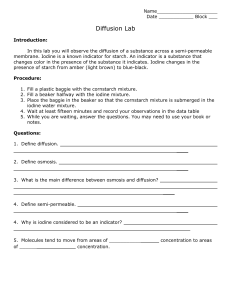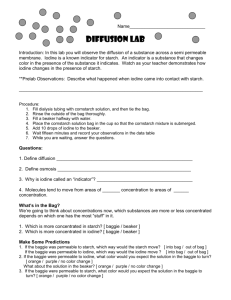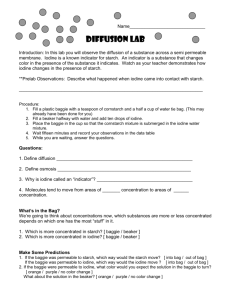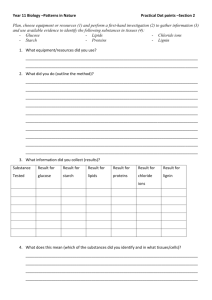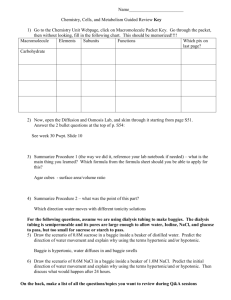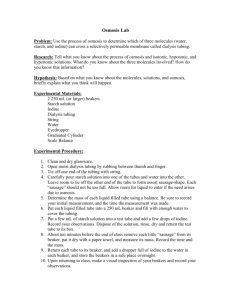Diffusion & Osmosis Lab
advertisement
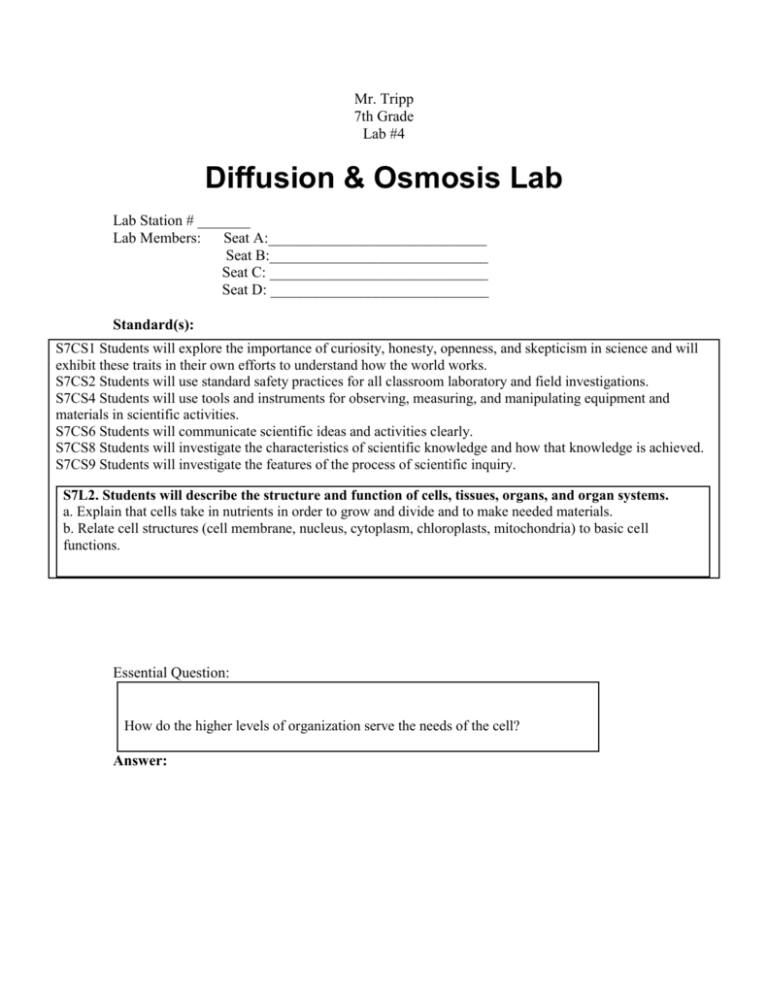
Mr. Tripp 7th Grade Lab #4 Diffusion & Osmosis Lab Lab Station # _______ Lab Members: Seat A:_____________________________ Seat B:_____________________________ Seat C: _____________________________ Seat D: _____________________________ Standard(s): S7CS1 Students will explore the importance of curiosity, honesty, openness, and skepticism in science and will exhibit these traits in their own efforts to understand how the world works. S7CS2 Students will use standard safety practices for all classroom laboratory and field investigations. S7CS4 Students will use tools and instruments for observing, measuring, and manipulating equipment and materials in scientific activities. S7CS6 Students will communicate scientific ideas and activities clearly. S7CS8 Students will investigate the characteristics of scientific knowledge and how that knowledge is achieved. S7CS9 Students will investigate the features of the process of scientific inquiry. S7L2. Students will describe the structure and function of cells, tissues, organs, and organ systems. a. Explain that cells take in nutrients in order to grow and divide and to make needed materials. b. Relate cell structures (cell membrane, nucleus, cytoplasm, chloroplasts, mitochondria) to basic cell functions. Essential Question: How do the higher levels of organization serve the needs of the cell? Answer: Part 1Introduction: In this lab you will observe the diffusion of a substance across a semi permeable membrane. Iodine is a known indicator for starch. An indicator is a substance that changes color in the presence of the substance it indicates. Watch as your teacher demonstrates how iodine changes in the presence of starch. Prelab Observations: Describe what happened when iodine came into contact with starch. Procedure: 1. Fill a plastic baggie with a teaspoon of corn starch and a half a cup of water tie bag. (This may already have been done for you) 2. Fill a beaker halfway with water and add ten drops of iodine. 3. Place the baggie in the cup so that the cornstarch mixture is submerged in the iodine water mixture. 4. Wait fifteen minutes and record your observations in the data table 5. While you are waiting, answer the questions. Questions: 1. Define diffusion. 2. Define osmosis 3. What is the main difference between osmosis and diffusion 4. Why is iodine called an indicator? 5. Molecules tend to move from areas of _______ concentration to areas of ______ concentration. What's in the Bag? We're going to think about concentrations now, which substances are more or less concentrated depends on which one has the most stuff in it. 1. Is the baggie or beaker more concentrated in starch? 2. Is the baggie or beaker more concentrated in iodine? 3. Iodine solution: is the baggie or the beaker hypertonic? 4. Starch solution: is the baggie or the beaker hypertonic? 5. Which one is hypotonic in relation to starch, baggie or beaker? Make Some Predictions 1. If the baggie was permeable to starch, which way would the starch move, into the bag or out of the bag? ________ 2. If the baggie was permeable to iodine, which way would the iodine move, into or out of the bag? _______ 3. If the baggie was permeable to iodine, what color would you expect the solution in the baggie to turn? _______ What about the solution in the beaker? ___________ 4. If the baggie was permeable to starch, what color would you expect the solution in the baggie to turn? ________ What about the solution in the beaker? _________ 5. Make a prediction about what you think will happen: Data Table Starting Color Color after 15 minutes Solution in Beaker Solution in Bag Post Lab Analysis 1. Based on your observations, which substance moved, the iodine or the starch? 2. How did you determine this? 3. The plastic baggie was permeable to which substance? 4. Is the plastic baggie selectively permeable? 5. Sketch the cup and baggie in the space below. Use arrows to illustrate how diffusion occurred in this lab. 6. What would happen if you did an experiment in which the iodine solution was placed in the baggie, and the starch solution was in the beaker? Be detailed in your description. 7. Why is it not a good idea to store iodine in a plastic bag? Part 2Lab: Osmosis in Red Onion Cells INTRODUCTION The passage of water molecules through a selectively permeable membrane is a special case of diffusion known as osmosis. Osmosis results in the movement of water from an area of lower concentration of dissolved material to an area of higher concentration of dissolved material. For a demonstration of this principle, a purple onion cell is going to be bathed in different concentrations of salt (NaCl) water. BACKGROUND In comparing two solutions of unequal solute concentration, the solution with a greater concentration of solutes is said to be hypertonic. The solution with the lesser solute concentration is hypotonic. These are relative terms that are only meaningful in a comparative sense. For example, tap water is hypertonic to distilled water, but hypotonic to seawater. In other words, tap water has a higher concentration of solutes than distilled water, but a lower concentration than seawater. Solutions of equal solute concentration are said to be isotonic. The diffusion of water across a selectively permeable membrane is a special case of passive transport called osmosis. In a sense, the water is diffusing down its concentration gradient. The solution with the greater concentration of solute has the lesser concentration of solvent. The direction of osmosis is determined only by a difference in total solute concentration, not by the nature of the solutes. Water will move from a hypotonic to a hypertonic solution even if the hypotonic solution has more kinds of solutes. Seawater, which has a great variety of solutes, will lose water to a solution of sugar that is very concentrated, because the total solute concentration of the seawater is less. It should be noted that there is no net movement of water between isotonic solution separated by a membrane. In this demonstration, the purple pigment visibly responds to the changes in the salt concentration. Sodium molecules are too large to pass through the cell membrane so the water moves in and out of the cell to maintain the proper cell pressure. Problem: How do solutions of various salt concentrations influence osmosis in relation to an onion cell? Hypothesis: ______________________________________________________________________________________ _____________________ ______________________________________________________________________________________ _____________________ Materials: (per student student group): red onion epidermis, forceps, dropper, distilled water, 5% or high percentage sodium chloride (table salt) solution, paper towels, microscope, slide, and cover slip PROCEDURE: 1. Make a wet mount of the red onion epidermis. 2. Examine under low power.. When you have a clear view of several cells, switch to high power. Make a labeled drawing, properly labeled in your data. This will give you a record of the original appearance of the onion cells. 3. Take a dropper and add several drops of salt solution to one side of your cover slip while placing a small piece of paper towel along the opposite edge of the cover slip. The paper should draw out the water and draw in the salt solution. 4. Observe the effects of the saline (salt) solution on the onion cells. Make a properly labeled, careful drawing of the cells' appearance in a second properly labeled carefully constructed drawing in your data. 5. Replace the sodium chloride solution with distilled water in the same way that the salt solution was added. Make a properly labeled drawing of the cells' appearance in your data. 6. Answer the questions which follow your data. Observations: ____Original appearance Saline solution____ Magnification ______________ Description ________________________________ Magnification ____________________ Description _______________________ _____Saline solution replaced with distilled water
